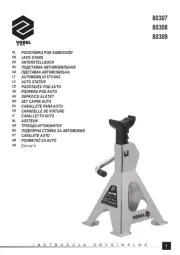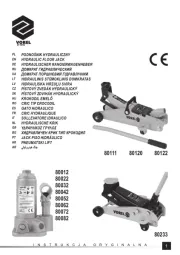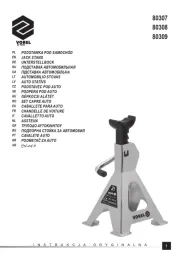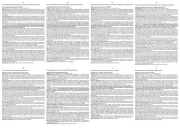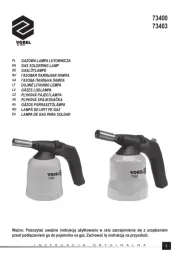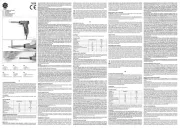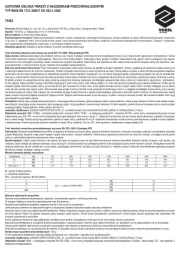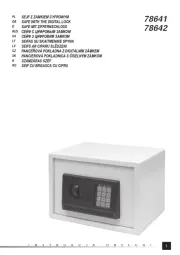
CHARAKTERYSTYKA NARZ DZIAĘ
Lutownica przeznaczona jest do czenia za pomoc lutowania materiałą ą łów metalowych za po-
mocą spoiw cynowo - ołowiowych do lutowania miękkiego. Przyrząd został zaprojektowany do
użytku wyłącznie w gospodarstwach domowych i nie może być wykorzystywany profesjonalnie, tj.
w zak adach pracy i do prac zarobkowych. Prawid owa, niezawodna i bezpieczna praca przyrzł ł ądu
jest zale na od w ciwej eksploatacji, dlatego: ż ł śaPrzed przystąpieniem do pracy z narzędziem
należy przeczytać całą instrukcję i zachować ją. Za wszelkie szkody i obraż łenia powsta e w
wyniku u dzia niezgodnie z przeznaczeniem, nie przestrzegania przepisów bezpie-żywania narzę
cze -ństwa i zaleceń niniejszej instrukcji dostawca nie ponosi odpowiedzialności. Używanie narzę
dzia niezgodnie z przeznaczeniem powoduje tak e utrat praw u ytkownika z tytu u gwarancji i ż ę ż ł
niezgodno ci z umow sprzedaś ą ży.
Lutownica dostarczana jest w stanie kompletnym i posiada wyposażenie dodatkowe: osł ęon
Parametr Jednostka miary Wartość
Cz stotliwo sieci [Hz] 50ę ść
Wymiary grotu lutownicy [mm] Ø3,8 x 70
Maksymalna temperatura grotu [
OGÓLNE WARUNKI BEZPIECZE STWAŃ
UWAGA! Przeczytać ż ż ć wszystkie poni sze instrukcje. Nieprzestrzeganie ich mo e prowadzi do
pora yte żenia elektrycznego, pożaru albo do uszkodzeń ciała. Pojęcie „narzędzie elektryczne” uż
w instrukcjach odnosi si do wszystkich narz dzi nap dzanych pr dem elektrycznym zarówno ę ę ę ą
przewodowych jak i bezprzewodowych.
PRZESTRZEGA PONI SZYCH INSTRUKCJIĆ Ż
Miejsce pracy nale y utrzymywa wietlone i w czystoż ć dobrze oś ści. Nieporz dek i są łabe
oświetlenie mogą być przyczynami wypadków. Nie nale narz dziami elektrycz-ży pracować ę
nymi w środowisku o zwi kszonym ryzyku wybuchu, zawieraj cym palne ciecze, gazy lub ę ą
opary. Narzę ądzia elektryczne generuj iskry, które mog spowodowa ar w kontakcie z palny-ą ć poż
mi gazami lub oparami. Nie należy dopuszczać dzieci i osób postronnych do miejsca pracy.
Utrata koncentracji mo e spowodoważ ć
utrat kontroli nad narz dziem.ę ę
Bezpiecze stwo elektryczneń
Wtyczka przewodu elektrycznego musi pasowa do gniazdka sieciowego. Nie wolno mody-ć
fi kować wtyczki. Nie wolno stosowa adnych adapterów w celu przystosowania wtyczki ć ż
do gniazdka. Niemodyfi kowana wtyczka pasuj ca do gniazdka zmniejsza ryzyko pora enia prą ż ą-
dem elektrycznym. Unikać kontaktu z uziemionymi powierzchniami takimi jak rury, grzejniki
i ch Nie nale y na-łodziarki. Uziemienie ciała zwi ksza ryzyko pora enia pr dem elektrycznym. ę ż ą ż
ra a .ż ć narzędzi elektrycznych na kontakt z opadami atmosferycznymi lub wilgocią Woda i
wilgo dem ć, która dostanie się do wnętrza narzędzia elektrycznego zwiększa ryzyko porażenia prą
elektrycznym. Nie przeciąż ć ą ż ć ąa kabla zasilaj cego. Nie u ywa kabla zasilaj cego do nosze-
nia, podłączania i od czania wtyczki od gniazdka sieciowego. Unika kontaktu kabla za-łą ć
silającego z ciepłem, olejami, ostrymi krawędziami i ruchomymi elementami.
kabla zasilaj ksza ryzyko poraącego zwię żenia prądem elektrycznym. W przypadku pracy poza
pomieszczeniami zamkniętymi należy u aczy przeznaczonych do pracwy ż ćywa przedł żu
poza pomieszczeniami zamkniętymi. Uż ł życie odpowiedniego przed u acza zmniejsza ryzyko
pora enia pr dem elektrycznym.ż ą
Przystępuj do pracy w dobrej kondycji fi zycznej i psychicznej. Zwracaj uwag na to, co ę
robisz. Nie pracuj b ywem leków lub alkoholu.ę ąd c zmęczonym lub pod wpł Nawet chwi-
la nieuwagi podczas pracy mo do poważe prowadzić żnych obra ciaż ńeła. U ywaj rodków ż ś
ochrony osobistej. Zawsze zak adaj gogle ochronne.ł Stosowanie rodków ochrony osobistej, ś
takich jak maski przeciwpy owe, obuwie ochronne, kaski i ochronniki s uchu zmniejszaj ryzy-ł ł ą
ko powa nych obraż ż ńe ciała. Unikaj przypadkowego włą
czenia narzędzia. Upewnij się ż, e
włącznik elektryczny jest w pozycji „wyłączony” przed podłączeniem narzędzia do sieci
elektroenergetycznej. Trzymanie narzę łą łą ędzia z palcem na w czniku lub pod czanie narz dzia
elektrycznego, gdy w czony” mo e prowadzi do powa nych obrałącznik jest w pozycji „włą ż ć ż ż ńe
cia a. łPrzed włą ę ń ęczeniem narz dzia elektrycznego usu wszelkie klucze i inne narz dzia,
które zosta yte do jego regulacji.ły uż Klucz pozostawiony na obracaj cych si elementach ą ę
narz e a. ędzia może prowadzić do poważnych obraż ń ciałUtrzymuj równowagę ł. Przez ca y czas
utrzymuj odpowiedni postawą ę. Pozwoli to na atwiejsze zapanowanie nad narz dziem elek-ł ę
trycznym w przypadku niespodziewanych sytuacji podczas pracy. Stosuj odzie . Nie ż ochronną
adaj lu niej odzie uterii. Utrzymuj w osy, odzie i r kawice robocze z dala od ź ży i biż ł ż ę
ruchomych cz ci narzęś ędzia elektrycznego. Lu na odzie , bi uteria lub d ugie w osy mogź ż ż ł ł ą
zaczepi dzia. ć o ruchome części narzęStosuj odcią ł ł ś ęgi py u lub pojemniki na py , je li narz -
dzie jest w takie wyposa one. Zadbaj o to, aby je poprawnie podż łą ćczy . Użycie odci gu pyą łu
zmniejsza ryzyko powa nych obra e cia a. ż ż ń ł
U ytkowanie narz dzia elektrycznegoż ę
Nie przeci dzia elektrycznego. U dzia w ciwego do danej pracy.ążaj narzę żywaj narzę ł śa Od-
powiedni dobór narzędzia do danej pracy, zapewni wydajniejsz i bezpieczniejsz pracą ą ę. Nie
używaj narzędzia elektrycznego, jeśli nie działa jego włącznik sieciowy. Narzędzie, które nie
daje si kontrolowaę ć za pomocą włą ż ćcznika sieciowego jest niebezpieczne i nale y je odda do
naprawy. Odłącz wtyczkę od gniazdka zasilającego przed regulacją, wymianą akcesoriów
lub przechowywaniem narzędzia. Pozwoli to na uniknię łą ęcie przypadkowego w czenia narz -
dzia elektrycznego. Przechowuj narzędzie w miejscu niedost pnym dla dzieci. Nie pozwól ę
pracowa dzia.ć osobom nieprzeszkolonym w zakresie obsługi narzę Narzędzie elektryczne
mo ugi. że być niebezpieczne w rękach nieprzeszkolonej obsłZapewni wł ś ą ęa ciw konserwacj
narz ci. ędzia. Sprawdzaj narzędzie pod kątem niedopasowań i luzów ruchomych częś
Sprawdzaj czy jakikolwiek element narz dzia nie jest uszkodzony. W przypadku wykrycia ę
usterek nale y je naprawiż ć
przed użyciem narzędzia elektrycznego. Wiele wypadków jest
spowodowanych przez niew ciwe konserwowane narzł śaędzia. Narzędzia tnące należy utrzy-
mywać czyste i naostrzone. Wł ś ę ą ł ća ciwie konserwowane narz dzia tn ce jest atwiej kontrolowa
podczas pracy. Stosuj narzędzia elektryczne i akcesoria zgodnie z powyższymi instrukcja-
mi. Stosuj narzędzia zgodnie z przeznaczeniem bior c pod uwag rodzaj i warunki pracy.ą ę
Stosowanie narz ryzyko powsta-ędzi do innej pracy ni zosta y zaprojektowane moż ł że zwię ćkszy
wania niebezpiecznych sytuacji.
Naprawiaj narz dzie tylko w uprawnionych do tego zak adach, u cych tylko oryginal-ę ł ż ąywaj
nych części zamiennych. Zapewni to wł śa ciwe bezpiecze stwo pracy narz dzia elektrycznego. ń ę
INSTRUKCJE BEZPIECZE STWA U YTKOWANIAŃ Ż
Zabrania się uż ęytkowania lutownicy z przewężonym grotem. Zabrania si dotykania rozgrzanym
grotem izolacji przewodów elektrycznych. Zabrania się u
ż żywania lutownicy w warunkach podwy -
szonej wilgotno ci oraz w atmosferze gazów i py ów wybuchowych, i ś ł ż ąr cych. Nie wolno napra-
wiać uszkodzonych przewodów elektrycznych narzędzia. W przypadku uszkodzenia przewo-
du elektrycznego przyrz y wymieni go na nowy. Wymiana przewodu zasilajądu należ ć ącego
może być wykonana jedynie przez uprawnionego elektryka. Nie wolno lutować elementów
znajduj ciem! ących się pod napięPo pracy należy odł żo yć ę ę ć narz dzie na podstawk i pozwoli
ostygnąć lutownicy. Jest to jedyny dopuszczalny sposób ch odzenia narz dzia. Nie nale y studził ę ż ć
lutownicy wk c j do wody, mo e to spowodowa pora enie prładają ą ż ć ż ądem elektrycznym. Urządzenie
nie powinno by ytkowane przez dzieci lub osoby o ograniczonej sprawnoć ż u ści fi zycznej, czuciowej
i psychicznej lub przez osoby bez do wiadczenia i wiedzy, chyba e zostajś ż ą pod nadzorem lub
zosta y przeszkolone. Nale y nadzorowa dzieci, aby nie potraktowa y urzł ż ć ł ądzenia jako zabawkę.
IMONTA ELEMENTÓW WYPOSA ENIAŻ Ż
UWAGA! Monta -ż wyposażenia może być dokonywany tylko przy odłączonym napięciu zasilają
cym. Wyci gn wtyczk przewodu narz dzia z gniazda sieciowego!ą ąć ę ę
Upewni , ci ć się że lutownica i grot są zimne. Odkrę ć śruby mocujące grot i usunąć stary grot, w
jego miejscu mocując nowy. Dokr ruby mocuj ce za pomoc wkr taka. Upewni si e grot ę ć ści ą ą ę ć ę ż,
nie wysunie si samoczynnie podczas pracy. ę
Przed rozpocz y sprawdzięciem pracy należ ć, czy korpus obudowy oraz przewód przyłączeniowy
z wtyczk i zewn trzne przewody przedą ę
ł ż ą ą żu aj ce nie s uszkodzone. W razie potrzeby nale y
oczy ci niś ć narzędzie z zanieczyszczeń i udroż ć otwory wentylacyjne. W przypadku stwierdzenia
uszkodzeń zabrania się dalszej pracy! Uwaga! Wszystkie czynności związane z wymianą gro-
ta, żarówki itp. należy przeprowadzać przy wyłączonym napięciu zasilającym narzędzie, dlatego
przed przystąpieniem do tych czynności: Wyci gną ąć wtyczkę przewodu narzędzia z gniazda
sieciowego! Przed uż ę ż ć ę ąyciem narz dzia nale y upewni si , czy parametry sieci elektrycznej s
zgodne z danymi umieszczonymi na tabliczce znamionowej. Przed lutowaniem należy dokładnie
oczy ci ś ć łączone elementy metalowe, a także grot lutownicy. W przypadku przepalenia si grota ę
należy wymienić go na nowy. W przypadku pokrycia się
grotu warstw tlenków, moą ż ąna j usunąć
za pomocą delikatnego przeszlifowania papierem ciernym o gradacji 600 - 800. W przypadku ś
przepalenia si grotu nale y wymieni go na nowy.ę ż ć
Lutowanie powinna wykonywa a zapoznana z przepisami bezpiecze stwa i higie-ć osoba dorosł ń
ny pracy przy pracach zwi zanych z lutowaniem. Umie na podstawce (dostą ś ćci lutownicę ępna
osobno) i pod wtyczk kabla zasilaj cego do gniazdka. Za wieci si lampka kontrolna, a łą ćczy ę ą ś ę
lutownica rozpocznie nagrzewanie. Lutownica osi gnie nominaln grotu po upą ą temperaturę ływnie
oko niło 8 minut. Rozpocząć pracę. Uwaga! Naciś ęcie przycisku spowoduje szybsze nagrzanie
Po sko czonej pracy: wsun z oczyszczonym grotem w uchwyt, odń ąć lutownicę łą ćczy wtyczkę
kabla zasilaj cego od gniazda i pozostawią ć urz dzenie do ostygnią ę
cia. Nast pnie przyst do ę ą ćpi
czynno ci konserwacyjnych. ś
UWAGA! Przed przyst pieniem do regulacji, obs ugi technicznej lub konserwacji wyci gnij wtycz-ą ł ą
kę narzędzia z gniazdka sieci elektrycznej. Po zakończonej pracy należy sprawdzić stan tech-
niczny elektronarz : korpusu i r ci, przewodu ędzia poprzez ogl trzne i ocenędziny zewnę ę ę śkoje
elektrycznego z wtyczk i odgi , dzia ania w cznika elektrycznego, dro ci szczelin wen-ą ę ątk ł łą ż śno
tylacyjnych, iskrzenia szczotek, g ci pracy ysk i przek adni, rozruchu i równomiernoł ś śo no ł żoł ści
pracy. W okresie gwarancji u ytkownik nie mo e domontowa elektronarz dzi, ani wymieniaż ż ć ę ć
ż ł ęś ł ż ęadnych podzespo ów lub cz ci sk adowych, gdy powoduje to utrat praw gwarancyjnych.
ci obserwowane przy przeglądzie, lub w czasie pracy, s sygna em do ą ł
przeprowadzenia naprawy w punkcie serwisowym. Po zako czeniu pracy, obudow , szczeliny ń ę
wentylacyjne, prze czniki, r i os ony nale y oczy np. strumieniem powie-łą ę śćkoje dodatkową ł ż ś ćci
trza (o ci nieniu nie wi 0,3 MPa), p dzlem lub such szmatkś ększym niż ę ą ą bez uż śycia rodków
chemicznych i p ynów czyszcz cych. Narz dzia i uchwyty oczy ci such czyst szmat .ł ą ę ś ć ą ą ą
Ten symbol informuje o zakazie umieszczania zu ytego sprz tu elektrycznego i elektronicznego ż ę
(w tym baterii i akumulatorów) cznie z innymi odpadami. Zu yty sprz t powinien by zbierany łą ż ę ć
selektywnie i przekazany do punktu zbierania w celu zapewnienia jego recyklingu i odzysku, aby
ograniczać ilość odpadów oraz zmniejszyć stopnień wykorzystania zasobów naturalnych. Niekon-
trolowane uwalnianie składników niebezpiecznych zawartych w sprzęcie elektrycznym i elektronicznym
może stanowić zagrożenie dla zdrowia ludzkiego oraz powodować negatywne zmiany w środowisku na-
turalnym. Gospodarstwo domowe pe rol w przyczynianiu si do ponownego u ycia i odzysku, łni waż ąnę ę ż
w tym recyklingu zu ytego sprz tu. Wi cej informacji o w ciwych metodach recyklingu mo na uzyskaż ę ę ł śaż ć
u w adz lokalnych lub sprzedawcy. ł
4. przewód sieciowy z wtyczką
4. power supply cord with plug
4. Stromversorgungsleitung mit Stecker
2. punta de la pistola soldadora
4. cable eléctrico con clavija
4. сетевой провод с вилкой
The purpose of the soldering gun s to solder metal materials using tin and lead solders for soft
soldering. The device has been designed solely for domestic use and must not be used profes-
sionally, i.e. at factories and for lucrative purposes. A correct, reliable and safe functioning of
the device depends on proper its operation, so: Before commencing any work with the tool,
read the whole manual and keep it. The supplier shall not be held responsible for any damage
or injuries due to the tool’s being used for purposes other than intended or to inobservance of
safety regulations and the recommendations indicated in this manual. Using the tool for purposes
other than intended implies also a loss of the user´s guarantee rights, constituting a breach of
The soldering gun s supplied complete and along with additional item: soldering tip cover.
Parameter Measurement unit Value
Soldering tip dimensions [mm] Ø3,8 x 70
Maximum temperature of the soldering tip [
GENERAL SAFETY CONDITIONS
NOTE! Get acquainted with all the instructions below. Failure to observe them may lead to an
electric shock, fi re or injuries. The notion of electric tool used in the instructions applies to all the
tools which are powered with electric current, both wire tools and wireless ones.
OBSERVE THE FOLLOWING INSTRUCTIONS
The place of work must be properly illuminated and clean. Disorder and poor illumination
may be a cause of accidents. Do not work with electric tools in explosive environments, or
those which contain infl ammable liquids, gases or vapours. Electric tools generate sparks,
which may cause a fi re in case of contact with infl ammable gases or vapours. Do not allow
children and outsiders to the place of work. A lack of concentration may result in a loss of
The plug of the power supply cable must fi t the mains socket. Do not modify the plug. Do
not use any adapters whatsoever in order to adapt the plug to the socket. Unmodifi ed plug
which fi ts the socket reduces the risk of an electric shock. Avoid contact with grounded surfac-
es, such as pipes, heaters and refrigerators. Grounding of the body increases the risk of an
electric shock. Do not expose electric tools to precipitation or humidity. Water and humidity
which gets into the electric tool increases the risk of an electric shock. Do not overload the power
supply cable. Do not use the power supply cable in order to carry the tool or to connect and
disconnect the plug from the mains socket. Avoid contact of the power supply cable with
heat, oils, sharp tools and moving elements. Damage to the power supply cable increases the
risk of an electric shock. In case work is realised outside closed areas, it is necessary to use
extension cords designed for applications outside closed areas. Using a correct extension
cord permits to reduce the risk of an electric shock.
Commence work in good physical and psychological conditions. Pay attention to what
you do. Do not work if you are tired or under eff ects of medicines or alcohol. Even a mo-
ment’s inattention during work may lead to serious injuries. Always use individual means of
protection. Always wear goggles. Using individual means of protection, such as dust-masks,
protective shoes, helmets and hearing protections permits to reduce the risk of serious injuries.
Avoid accidental activation of the tool. Make sure the switch is in the OFF position, before
you connect the tool to the mains. Holding the tool with a fi nger on the switch or connecting
an electric tool when the switch is in the ON position may lead to serious injuries. Before you
turn an electric tool on remove all the spanners and other tools, which have been used for
adjustments. A spanner left on rotating elements of the tool may lead to serious injuries. Keep
your balance. Maintain an appropriate position. It will permit to control the electric tool in
case of unpredicted situations during its operation. Use protective clothes. Do not wear loose
clothes or jewellery. Keep your hair, clothes and gloves away from moving elements of the
electric tool. Loose clothes, jewellery or long hair may get caught on moving elements of the tool.
Use dust extractors or dust containers, if the tool is equipped with any. Make sure they
are properly connected. Using of dust extractors permits to reduce the risk of serious injuries.
Operation of the electric tool
Do not overload the electric tool. Use a proper tool for the given purpose. A correct selection
of the tool for the given work will result in a more effi cient and safer work. Do not use the electric
tool if the switch is not functioning properly. A tool which may not be controlled by means
of a switch is dangerous and must be repaired. Disconnect the plug from the mains socket
before any adjustment, replacement of accessories or storage of the tool. It will permit to
avoid accidental activation of the electric tool. Store the tool away from children. Do not allow
untrained persons to operate the tool. An electric tool may be dangerous in hands of an un-
trained person. Make sure the tool is properly maintained. Check the tool in order to detects
any unfi tting or loose moving elements. Check whether the elements of the tool are not
damaged. In case any damaged elements of the tool are detected, they must be repaired
before the electric tool is operated. Many accidents are caused by improper maintenance of
tools. Cutting tools must be sharp and clean. Properly maintained cutting tools are easier to
control during work. Use electric tools and accessories in accordance with the aforemen-
tioned instructions. Use the tool in accordance with its purpose, taking into account the
kind and conditions of work. Should the tool be used for other applications than the ones it has
been designed for, the risk of a dangerous situation increases.
The tool may be repaired only by authorised service centres, which must use solely original
spare parts. It will guarantee a proper level of safety of operation of the electric tool.
SAFE OPERATION INSTRUCTIONS
It is prohibited to use soldering gun with a worn-out soldering tip. It is prohibited to touch insulation
of electric conductors with a hot soldering tip. It is prohibited to use the soldering gun under high
humidity conditions and in explosive and caustic gases and powders atmospheres. Do not repair
damaged electric conductors of the tool. In case the electric cord of the device is damaged,
it must be replaced with a new one. The power supply cord must be realised by a qualifi ed
electrician. Do not solder live elements! Having concluded work place the tool on the stand
and wait until the soldering gun has cooled down. This is the only acceptable manner of cooling
the tool. Do not cool the soldering gun down putting it in water, which may cause electric shock.
This appliance is not to be used by children or persons with reduced physical, sensory or mental
capabilities or lack of experience and knowledge if they have been given supervision or instruction
concerning use of the appliance in a safe way and understand the hazards involved. Children shall
not play with the appliance.
INSTALLATION OF THE ACCESSORIES
ATTENTION! Installation of the accessories must be realised while the power supply voltage is
off . Remove the plug of the tool cord from the mains socket!
Replacement of the soldering tip (II)
Make sure the soldering gun and the soldering tip are cold. Remove the bolts the soldering tip is
fi xed with and remove the soldering tip, to replace it with a new one. Tighten the fi xing bolts, using
a screwdriver. Make sure the soldering tip shall not come out during work.
Before work s commenced make sure the housing and the electric cord and the plug, as well as
the external extension cables are not damaged. If necessary, clean the tool and its ventilation
slots. In case any damage is detected it is prohibited to continue working! Any actions Attention!
related to replacement of the soldering tip, the light bulb, etc. must be realised when the power
supply voltage of the tool is off , se before you proceed to carry them out: Remove the tool
power supply cord plug from the mains socket! Before using the tool make sure the mains
parameters coincide with the values indicated in the rating plate. Before soldering it is required to
thoroughly clean the metal elements to be soldered, as well as the soldering tip of the soldering
gun. In case the soldering tip has been burnt, it must be replaced with a new one. If the soldering
tipi s covered with an oxide layer, it may be removed polishing slightly the tip with abrasive paper
600-800 grain. In case the soldering tip has been burnt, it must be replaced with a new one.
Soldering must be realised by an adult who has acquainted themselves with safety regulations
regarding activities involving soldering. Place the soldering gun on the stand (supplied separately)
and plug the power supply cord to the mains. A control lamp will go on, and the soldering gun will
start to heat up. The soldering gun shall reach the maximum temperature of the soldering tip after
approximately eight 8 minutes. The tool is ready for work. Attention! If the button is pressed the
soldering gun will heat up faster. After the work has concluded place the soldering gun with a clean
soldering tip in the holder, unplug the power supply cord from the mains and leave the tool to cool
down. Proceed to maintenance.
ATTENTION! Before any adjustment, technical service or maintenance operations unplug the tool.
Once the operations have been fi nished, the technical conditions of the tool must be assessed
by means of external evaluation and inspection of the following elements: body and handle, con-
ductor with a plug and defl ection, functioning of the electric switch, patency of ventilation slots,
sparking of brushes, noise level of functioning of bearings and gears, start-up and smoothness of
operation. During the guarantee period, the user cannot dismantle the electric tools or change any
sub-assemblies or elements, since it will cancel any guarantee rights. All irregularities detected at
overhaul or during functioning of the tools are a signal to have the tool repaired at a service shop.
Once the functioning has been concluded, the casing, ventilation slots, switches, additional han-
dle and protections must be cleansed with a stream of air (at a pressure not exceeding 0.3 MPa),
with a brush or a cloth without any chemical substances or cleaning liquids. Tools and handles
must be cleansed with a clean cloth.
This symbol indicates that waste electrical and electronic equipment (including batteries and sto-
rage cells) cannot be disposed of with other types of waste. Waste equipment should be collected
and handed over separately to a collection point for recycling and recovery, in order to reduce the
amount of waste and the use of natural resources. Uncontrolled release of hazardous components
contained in electrical and electronic equipment may pose a risk to human health and have adverse
eff ects for the environment. The household plays an important role in contributing to reuse and recovery,
including recycling of waste equipment. For more information about the appropriate recycling methods,
contact your local authority or retailer.
Die Elektrowerkzeuge dürfen dem Einfl uss von atmosphärischen Niederschlägen oder Der
Feuchtigkeit nicht ausgesetzt werden. Wasser und Feuchtigkeit, die in das Innere des Elektro-
werkzeuges eindringen, erhöhen die Gefahr des elektrischen Schlages. Den Netzkabel nicht
überlasten. Die Netzkabel nicht zum Tragen, Abschalten und Einschalten des Leitungs-
steckers zum Netzsteckdose verwenden. Den Kontakt des Leitungskabels mit der Wärme,
Öl, scharfen Kanten und beweglichen Teilen vermeiden. Beschädigung des Leitungskabels
erhöht die Gefahr des elektrischen Schlages. Be idem Einsatz außerhalb der geschlossener
Räumen sollen für Außen geeignete Verlängerungsschnüre verwendet werden. Die Verwen-
dung der geeigneten Verlängerungsschnüre vermindert die Gefahr des elektrischen Schlages.
Dei Arbeit soll bei guter körperlicher und geistlicher Verfassung ausgeführt werden. Im-
mer darauf achten was gemacht wird. Die Arbeit darf nicht bei der Ermündung oder unter
Einfl uss von Alkohol oder Medikamenten ausgeführt werden. Sogar eine momentane Un-
aufmerksamkeit während der Arbeit kann zu ernsthaften Körperverletzungen führen. Die persön-
lichen Schutzmittel verwenden. Immer die Schutzbrille tragen. Die Verwendung von persön-
lichen Schutzmitteln wie Staubmasken, Schutzschuhe, Helme und Gehörschutz vermindern die
Gefahr der ernsthaften Körperverletzungen. Das zufällige Einschalten des Elektrowerkzeuges
vermeiden. Bitte prüfen ob der Schalter in der Stellung „AUS” steht bevor das Elektrowerk-
zeug an das elektrische Netz angeschlossen wird. Das Halten der Finger auf dem Schalter
oder Anschluss des Elektrowerkzeuges bei dem eingeschalteten Schalter kann zu ernsthaften
Körperverletzungen führen. Vor Einschalten des Elektrowerkzeuges sollen alle Schlüssel
und Werkzeuge entfernt werden, die zur Einstellung verwendet worden waren. Der an den
beweglichen Teilen des Werkzeuges hintergelassene Schlüssel kann ernsthafte Körperverletzun-
gen herbeiführen. Gleichgewicht halten. Durch die ganze Zeit entsprechende Arbeitsstel-
lung einnehmen. Dadurch lässt sich das Elektrowerkzeug in den unerwarteten Notfällen bei
der Arbeit leichter beherrschen. Schutzkleidung tragen. Keine lose Kleidung oder Schmuck
tragen. Haare, Kleidung und Arbeitshandschuhe fern von den beweglichen Teilen des
Elektrowerkzeuges halten. Lose Kleidung, Schmuck oder lange Haare können an die beweg-
liche Teile des Elektrowerkzeuges anhaken. Staubabsaugung oder Staubbehälter verwenden
falls das Werkzeug damit ausgestattet wird. Bitte sorgen Sie dafür damit sie sachgemäß
angeschlossen sind. Verwendung der Staubabsaugung vermindert die Gefahr der ernsthaften
Verwendung des Elektrowerkzeuges
Das Elektrowerkzeug nicht überlasten. Das zur ausführende Aufgabe geeignete Werkzeug
verwenden. Entsprechende Auswahl des Werkzeuges gewährleistet eine leistungsfähige und
sichere Arbeit. Das Werkzeug darf nicht verwendet werden, falls der Netzschalter nicht
funktioniert. Das Werkzug, welches sich mit dem Schalter nicht kontrollieren lässt, ist gefährlich
und soll zur Reparatur geliefert werden. Den Leitungsstecker von der Netzsteckdose heraus-
ziehen wenn das Werkzeug eingestellt oder Zubehör ausgetauscht bzw. das Werkzeug auf-
bewahrt wird. Dadurch wird das zufällige Einschalten des Elektrowerkzeuges vermieden. Das
Elektrowerkzeug vor den Zutritt von Kindern schützen. Die bei der Bedienung des Werk-
zeuges nicht eingeschulten Personen dürfen das Werkzeug nicht verwenden. Das Elektro-
werkzeug kann in den Händen der nicht geschulten Personen gefährlich sein. Entsprechende
Instandhaltung des Werkzeuges gewährleisten. Das Werkzeug auf nicht eingepasste Teile
und Spiele der beweglichen Teile prüfen. Bitte überprüfen, ob irgendein Bestandteil des
Werkzeuges nicht beschädigt ist. Die Störungen sollen vor dem Einsatz des Werkzeugen
beseitigt werden. Viele Unfälle sind durch nicht sachgemäße Instandhaltung des Werkzeuges
verursacht. Schneidewerkzeugen sollten sauber und geschärft sein. Sachgemäß geschärfte
Schneidenwerkzeuge lassen sich besser während der Arbeit kontrollieren. Dei Elektrowerkzeu-
ge und Zubehör gemäß der vorstehenden Anweisungen benutzen. Die Werkzeuge entspre-
chend der Aufgabe und die Arbeitsbedingungen einsetzen. Die nicht bestimmungsgemäße
Verwendung des Werkzeuges kann das Risiko der Gefahren erhöhen .
Die Werkzeuge sollen nur in den autorisierten Werkstätten bei der Verwendung der Origi-
nalersatzteile repariert werden. Dadurch wird die entsprechende Arbeitssicherheit des Elektro-
werkzeuges gewährleistet .
SICHERHEITSHINWEISE FÜR DIE NUTZUNG
Der Einsatz eines Lötkolbens mit verjüngter Lötspitze ist verboten. Das Berühren der Isolation
elektrischer Leitung mit erwärmter Lötspitze ist verboten. Der Einsatz des Lötkolbens unter den
Bedingungen erhöhter Feuchtigkeit sowie in der Atmosphäre von Gasen sowie explosivem und
ätzendem Staub ist verboten. Beschädigte Elektroleitungen des Werkzeuges dürfen nicht
repariert werden. Bei einer Beschädigung der Elektroleitung des Gerätes muss man sie
gegen eine neue Leitung austauschen.Der Austausch der Stromversorgungsleitung darf
nur von einem dazu berechtigten Elektriker ausgeführt werden. Keine spannungsführende
Elemente löten! Nach dem Einsatz ist das Werkzeug auf eine Unterlage abzulegen, bis der Löt-
kolben abgekühlt ist. Das ist auch gleichzeitig die einzige zugelassene Methode der Abkühlung
des Werkzeuges, d.h. man darf es auch nicht im Wasser abkühlen, da dies zu einem elektrischen
MONTAGE DER AUSRÜSTUNGSELEMENTE
HINWEIS! Die Montage der Ausrüstung darf nur bei abgeschalteter Stromversorgungsspannung
durchgeführt werden. Den Stecker der Anschlussleitung des Gerätes aus der Netzsteckdose
Zunächst muss man sich davon überzeugen, ob der Lötkolben und die Spitze kalt sind. Die Be-
festigungsschraube für die Lötspitze abschrauben, die alte Lötspitze entfernen und an ihre Stelle
die neue befestigen. Die Befestigungsschraube mit einem Schraubenzieher wieder anschrauben.
Abschließend muss man sich davon überzeugen, dass sich die Lötspitze während des Funktions-
betriebes nicht von selbst herausschiebt.
Vor Beginn des Funktionsbetriebes muss man überprüfen, ob das Gehäuse und die Anschlusslei-
tung mit Stecker sowie die Außenleitungen zur Verlängerung nicht beschädigt sind. Im Bedarfsfall
muss man das Werkzeug auch reinigen, die Verschmutzungen entfernen und die Durchlässigkeit
der Lüftungsöff nungen gewährleisten. Wenn Beschädigungen festgestellt werden, ist der weitere
Betrieb verboten! mit dem Wechsel der Lötspit-Hinweis! Alle Tätigkeiten im Zusammenhang
ze, der Glühlampe usw. sind bei ausgeschalteter Stromversorgungsspannung des Werkzeuges
durchzuführen, deshalb muss man vor Beginn dieser Tätigkeiten: Den Stecker der Leitung des
Werkzeuges aus der Netzsteckdose ziehen! Vor Gebrauch des Werkzeuges muss man sich
davon überzeugen, ob die Parameter des Elektronetzes mit den Angaben auf dem Leistungs-
schild übereinstimmen. Vor dem Löten sind die zu verbindenden Metallelemente, sowie aber auch
die Lötkolbenspitze, gründlich zu reinigen. Bei einem Verbrennen der Lötspitze muss man sie
gegen eine neue austauschen. Wenn die Lötspitze mit einer Oxidschicht bedeckt ist, muss sie
mit einem Schleifpapier der Gradation von 600 – 800 delikat abgeschliff en werden. Bei einem
Verbrennen der Lötspitze muss man sie gegen eine neue austauschen.
Das Löten muss von einer erwachsenen Person ausgeführt werden, die sich mit den Arbeits- und
Hygienevorschriften bei Lötarbeiten auskennt. Der Lötkolben ist auf einer Unterlage (gesondert
zugänglich) abzulegen und den Stecker der Stromversorgungsleitung in die Steckdose zu ste-
cken. Dann leuchtet eine Kontrolllampe auf und der Lötkolben wird aufgeheizt. Nach Ablauf von
ungefähr 8 Minuten erreicht die Lötspitze ihre Betriebstemperatur. Jetzt kann man mit der Arbeit
Hinweis! Das Drücken der Taste bewirkt ein schnelleres Aufheizen des Lötkolbens. Nach Beendi-
gung der Arbeit: Den Lötkolben mit gereinigter Lötspitze in die Halterung schieben, den Stecker
der Stromversorgungsleitung aus der Steckdose ziehen und das Gerät abkühlen lassen. Danach
beginnt man mit den Wartungsarbeiten.
KONSERVIERUNG UND ÜBERSICHTUNGEN
ACHTUNG! Vor dem Beitritt zur Regulierung, technischen Bedienung und Konservierung soll man
die Einrichtung von der Elektronetz durch die Herausziehung des Steckers aus der Netzdose
abschalten. Nach der Beendung der Arbeit soll man technischen Stand durch äußere Besich-
tigungen und die Beurteilung von: Gestell und Handgriff , Elektroleitung mit Stecker und Abbie-
gungsstück, Tätigkeit des Elektroschalters, Durchgängigkeit von Lüftungsschlitzen, Funken von
4. sí ový kabel se zástr kouť č
CHARAKTERISTIK DES WERKZEUGES
Der Lötkolben ist zum Verbinden von Metallelementen mit Hilfe von Zinn-Bleinähten durch Weich-
löten bestimmt. Er wurde ausschließlich für die Nutzung im Haushalt projektiert und darf nicht
gewerblich genutzt werden, d.h. in Betrieben und für Lohnarbeiten. Eine richtige, zuverlässige
und sichere Arbeit hängt von der entsprechenden Nutzung ab, deshalb: Vor Beginn der Arbeiten
mit dem Gerät ist die komplette Betriebsanleitung durchzulesen und auch einzuhalten. Für
sämtliche Schäden und Verletzungen, die im Ergebnis einer nicht sachgemäßen Anwendung des
Werkzeuges sowie der Nichteinhaltung von Sicherheitsvorschriften und Empfehlungen der vor-
liegenden Anleitung entstanden, übernimmt der Lieferant keine Verantwortung. Die Verwendung
des Werkzeuges nicht entsprechend dem Verwendungszweck bewirkt auch den Verlust der Ver-
braucherrechte betreff s Garantie und Haftung.
Der Lötkolben wird im kompletten Zustand angeliefert.
Parameter Maßeinheit Wert
Abmessungen der Lötspitze [mm] Ø3,8 x 70
Max. Temperatur der Lötspitze [
ACHTUNG! Die nachstehenden Anweisungen durchlesen. Die Nichteinhaltung der nachstehen-
den Anweisungen kann einen elektrischen Schlag, Brand oder Körperverletzungen führen. Der
Begriff „Elektrowerkzeug” bezieht sich auf alle mit dem elektrischen Strom angetriebenen Werk-
zeuge sowohl mit der Netzleitung als auch ohne Netzleitung.
DIE NACHSTEHENDEN ANWEISUNGEN EINHALTEN!
Der Arbeitsplatz soll gut beleuchtet sein und In der Sauberkeit gehalten werden. Das Durch-
einander und nicht ausreichende Beleuchtung können Arbeitsunfälle verursachen. Die Elek-
trowerkzeuge dürfen in der Umgebung mit erhöhter Explosionsgefahr, oder brennbaren
Flüssigkeiten Gasen oder Dunste nicht verwendet werden. Die Elektrowerkzeuge erzeugen
Funken, die in Berührung mit brennbaren Gasen oder Dunsten Brand verursachen können. Kin-
dern und unbefugte Personen fern von dem Arbeitsplatz halten. Die Konzentrationsschwä-
che kann zum Verlieren des Beherrschens über dem Werkzeug führen.
Leitungsstecker muss an die Netzsteckdose passen. Der Stecker darf nicht modifi ziert wer-
den. Keine Adapter zur Anpassung des Leitungssteckers an die Netzsteckdose verwenden.
Der nicht modifi zierte Leitungsstecker, der genau an die Netzsteckdose passt vermindert die Ge-
fahr des elektrischen Schlages. Den Kontakt mit geerdeten Flächen wie Rohre, Heizkörper,
Kühlschränke vermeiden. Die Körpererdung erhöht das Risiko des elektrischen Schlages.
